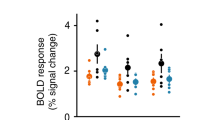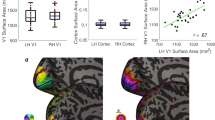Abstract
It is well established that attention increases the efficiency of information processing, but the neural mechanisms underlying this improvement are not fully understood. Evidence indicates that neural firing rates increase for attended stimuli, but another possibility is that attention could increase the selectivity of the neural population representing an attended stimulus. We tested this latter hypothesis by using functional magnetic resonance imaging (fMRI) to measure population selectivity for object views under different attention conditions in the human lateral occipital complex (LOC). Our data not only show increased neural activity (or 'gain') with attention, consistent with existing models, but also increased population selectivity that cannot be accounted for by gain mechanisms alone. Our results suggest that attention increases the specificity of the neural population representing an attended object.
This is a preview of subscription content, access via your institution
Access options
Subscribe to this journal
Receive 12 print issues and online access
$209.00 per year
only $17.42 per issue
Buy this article
- Purchase on Springer Link
- Instant access to full article PDF
Prices may be subject to local taxes which are calculated during checkout





Similar content being viewed by others
References
Rensink, R.A., O'Regan, J.K. & Clark, J.J. To see or not to see: the need for attention to perceive changes in scenes. Psychol. Sci. 8, 368–373 (1997).
Simons, D.J. Attentional capture and inattentional blindness. Trends Cogn. Sci. 4, 147–155 (2000).
Moran, J. & Desimone, R. Selective attention gates visual processing in the extrastriate cortex. Science 229, 782–784 (1985).
Luck, S.J., Chelazzi, L., Hillyard, S.A. & Desimone, R. Neural mechanisms of spatial selective attention in areas V1, V2 and V4 of macaque visual cortex. J. Neurophysiol. 77, 24–42 (1997).
Hillyard, S.A., Vogel, E.K. & Luck, S.J. Sensory gain control (amplification) as a mechanism of selective attention: electrophysiological and neuroimaging evidence. Phil. Trans. R. Soc. Lond. B.Biol. Sci. 353, 1257–1270 (1998).
Maunsell, J.H.R. & Cook, E.P. The role of attention in visual processing. Phil. Trans. R. Soc. Lond. B. Biol. Sci. 357, 1063–1072 (2002).
Spitzer, H., Desimone, R. & Moran, J. Increased attention enhances both behavioral and neuronal performance. Science 240, 338–340 (1988).
Haenny, P.E. & Schiller, P.H. State dependent activity in monkey visual cortex. I. Single cell activity in V1 and V4 on visual tasks. Exp. Brain Res. 69, 225–244 (1988).
McAdams, C.J. & Maunsell, J.H.R. Effects of attention on orientation-tuning functions of single neurons in macaque cortical area V4. J. Neurosci. 19, 431–441 (1999).
Treue, S. & Martinez Trujillo, J.C. Feature-based attention influences motion processing gain in macaque visual cortex. Nature 399, 575–579 (1999).
Treue, S. & Maunsell, J.H.R. Effects of attention on the processing of motion in macaque middle temporal and medial superior temporal visual cortical areas. J. Neurosci. 19, 7591–7602 (1999).
Pasupathy, A. & Connor, C.E. Population coding of shape in area V4. Nat. Neurosci. 5, 1332–1338 (2002).
Malach, R. et al. Object-related activity revealed by functional magnetic resonance imaging in human occipital cortex. Proc. Natl. Acad. Sci. USA 92, 8135–8139 (1995).
Kanwisher, N., Woods, R., Iacoboni, M. & Mazziotta, J. A locus in human extrastriate cortex for visual shape analysis. J. Cogn. Neurosci. 9, 133–142 (1997).
Grill-Spector, K., Kushnir, T., Edelman, S., Itzchak, Y. & Malach, R. Cue-invariant activation in object-related areas of the human occipital lobe. Neuron 21, 191–202 (1998).
Kourtzi, Z. & Kanwisher, N. Cortical regions involved in perceiving object shape. J. Neurosci. 20, 3310–3318 (2000).
Buckner, R.L. et al. Functional-anatomic correlates of object priming in humans revealed by rapid presentation event-related fMRI. Neuron 20, 285–296 (1998).
Miller, E.K., Li, L. & Desimone, R. A neural mechanism for working and recognition memory in inferior temporal cortex. Science 254, 1377–1379 (1991).
Grill-Spector, K. et al. Differential processing of objects under various viewing conditions in the human lateral occipital complex. Neuron 24, 187–203 (1999).
Kourtzi, Z. & Kanwisher, N. Representation of perceived object shape by the human lateral occipital complex. Science 293, 1506–1509 (2001).
Grill-Spector, K. & Malach, R. fMR-adaptation: a tool for studying the functional properties of human cortical neurons. Acta Psychol. (Amst.) 103, 293–321 (2001).
Bülthoff, H.H. & Edelman, S.Y. Psychophysical support for a two-dimensional view interpolation theory of object recognition. Proc. Natl. Acad. Sci. USA 89, 60–64 (1992).
Tarr, M.J., Williams, P., Hayward, W.G. & Gauthier, I. Three-dimensional object recognition is viewpoint dependent. Nat. Neurosci. 1, 275–277 (1998).
Logothetis, N.K. & Pauls, J. Psychophysical and physiological evidence for viewer-centered object representations in the primate. Cereb. Cortex 3, 270–288 (1995).
Logothetis, N.K., Pauls, J. & Poggio, T. Shape representation in the inferior temporal cortex of monkeys. Curr. Biol. 5, 552–563 (1995).
James, T.W., Humphrey, G.K., Gati, J.S., Menon, R.S. & Goodale, M.A. Differential effects of viewpoint on object-driven activation in dorsal and ventral streams. Neuron 35, 793–801 (2002).
Vuilleumier, P., Henson, R.N., Driver, J. & Dolan, R.J. Multiple levels of visual object constancy revealed by event-related fMRI of repetition priming. Nat. Neurosci. 5, 491–499 (2002).
Boynton, G.M. & Finney, E.M. Orientation-specific adaptation in human visual cortex. J. Neurosci. 23, 8781–8787 (2003).
Corbetta, M., Miezin, F.M., Dobmeyer, S., Shulman, G.L. & Petersen, S.E. Attentional modulation of neural processing of shape, color, and velocity in humans. Science 248, 1556–1559 (1990).
O'Craven, K.M., Rosen, B.R., Kwong, K.K., Treisman, A. & Savoy, R.L. Voluntary attention modulates fMRI activity in human MT-MST. Neuron 18, 591–598 (1997).
Wojciulik, E., Kanwisher, N. & Driver, J. Covert visual attention modulates face-specific activity in the human fusiform gyrus: fMRI study. J. Neurophysiol. 79, 1574–1578 (1998).
Reynolds, J.H., Pasternak, T. & Desimone, R. Attention increases sensitivity of V4 neurons. Neuron 26, 703–714 (2000).
Yeshurun, Y. & Carrasco, M. Attention improves or impairs visual performance by enhancing spatial resolution. Nature 396, 72–75 (1998).
Yeshurun, Y. & Carrasco, M. Spatial attention improves performance in spatial resolution tasks. Vis. Res. 39, 293–306 (1999).
Dale, A.M., Fischl, B. & Sereno, M.I. Cortical surface-based analysis. I. Segmentation and surface reconstruction. Neuroimage 9, 179–194 (1999).
Fischl, B., Sereno, M.I. & Dale, A.M. Cortical surface-based analysis. II: Inflation, flattening, and a surface-based coordinate system. Neuroimage 9, 195–207 (1999).
Buracas, G.T. & Boynton, G.M. Efficient design of event-related fMRI experiments using M-sequences. Neuroimage 16, 801–813 (2002).
Acknowledgements
We thank D. Kersten, B. Olshausen, M. Usrey, D. Woods, C. Petkov and C. Ranganath for comments on earlier versions, and N. Kanwisher for many helpful suggestions and discussions.
Author information
Authors and Affiliations
Corresponding author
Ethics declarations
Competing interests
The authors declare no competing financial interests.
Supplementary information
Supplementary Fig. 1
Examples of all of the 40 object shapes used in Experiments 1 and 2. Actual image files and software used to present them are available for download at www.neurobs.com. (PDF 235 kb)
Supplementary Fig. 2
Percent signal change in the left and right LOC. No differences were observed between the two hemispheres in the magnitude effect, the rotation-dependent responses, or the task by rotation interaction. (PDF 66 kb)
Supplementary Fig. 3
V1/V2 results for Experiment 1. No significant main effects or interactions were observed. (PDF 50 kb)
Rights and permissions
About this article
Cite this article
Murray, S., Wojciulik, E. Attention increases neural selectivity in the human lateral occipital complex. Nat Neurosci 7, 70–74 (2004). https://doi.org/10.1038/nn1161
Received:
Accepted:
Published:
Issue Date:
DOI: https://doi.org/10.1038/nn1161
This article is cited by
-
An Integrated Computational Framework for the Neurobiology of Memory Based on the ACT-R Declarative Memory System
Computational Brain & Behavior (2024)
-
The Imbalance of Wanting and Liking Contributes to a Bias of Internal Attention Towards Positive Consequences of Tobacco Smoking
International Journal of Mental Health and Addiction (2023)
-
The impact of aging on human brain network target controllability
Brain Structure and Function (2022)
-
Human brain activity reflecting facial attractiveness from skin reflection
Scientific Reports (2021)
-
Object responses are highly malleable, rather than invariant, with changes in object appearance
Scientific Reports (2020)



